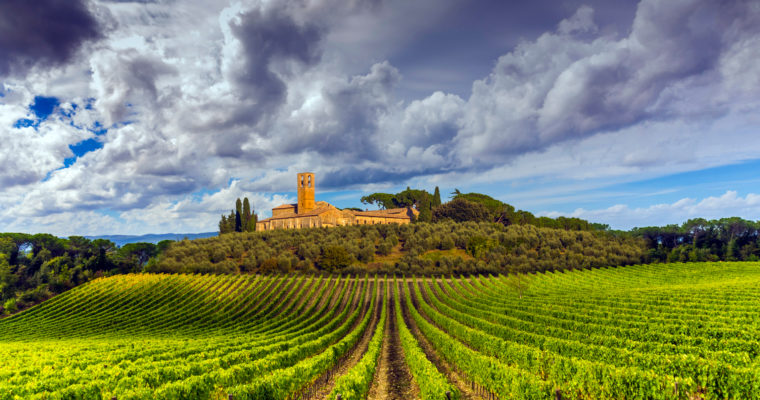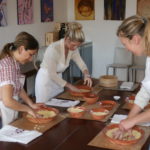I know I’m a little weird in the fact that I LIKE to learn about cooking while on vacation. Ever heard of a culinary vacation? Or how many of you have taken cooking classes while on holiday? I know that some of you are secretly raising your hands. Ok, I thought so…maybe I’m not all that weird…Read on to find out more about our incredible Sardinia culinary experience and all that we learned!
A Culinary…Vacation?
We discovered early on in our travels that we were interested in the great local, slow food scene. I’m not just speaking of farm-to-table because that movement has been around for decades, yet only recently practiced throughout our country. I’m talking about the food scene you experience while traveling abroad. Friends…I’m specifically speaking of the Europeans. They have it down. And, I mean nailed down. The Europeans have this magical way of letting food be their shepherd in life. The way I describe a slow food scene is one of letting locally-sourced and available ingredients dictate your culinary path for the day while enjoying it to the fullest (taking siestas, anyone?) with those you love.
On an incredible journey to southern Sardinia, we had the pleasure of touring around for a full week, enjoying its breathtaking landscapes and beaches, as well as getting to know locals and embracing the southern Italian food scene. Through this opportunity, we were able to visit a local vineyard, coupled with a local cooking class taught right inside the winery.

The Perfect Sardinia Culinary Experience At Argiolas Winery
Before getting to Sardinia, we knew we wanted to partake in an authentic culinary experience. After a little searching, we found Argiolas Winery. It is located in Serdiana, just north of the capital city, Cagliari. Argiolas Winery offered us a wine tasting opportunity as well as an authentic Sardinian culinary experience taught right at the estate. BOOM, we have a winner, folks! This opportunity was all things perfection rolled right into one day! Wine tasting + cooking class. I’m unsure a vacation day could get any better?
Now, this wasn’t a typical cooking class where you pay your money and get a 2-hour lesson. Don’t get me wrong, those are perfectly fine, too. This culinary experience was the very definition of a slow food cooking class.
The Culinary Experience
We arrived sometime mid-morning and were generously greeted with cheek kisses and hugs! The woman working at the Argiolas Wine Shop was an absolute gem! I’m half Sicilian so warm embraces from perfect strangers are totally my love language. We immediately felt transported onto a different planet as we were whisked away into the hands of Matilda and her expert partners to get started for the day.
As we entered the facility for our Sardinia culinary experience, I felt like I was teleported back to c. 1988 in my nana’s kitchen…the warm colors of the terracotta floor tiles & ceiling along with the stained glass windows instantly flooded me with memories of growing up eating handmade gnocchi and red sauce in my grandmother’s kitchen. Of course, she was yelling at us in Italian the entire time to get the heck out of her kitchen, but who cares? It still reminded me of her. Entering the Argiolas winery kitchen was love at first sight.
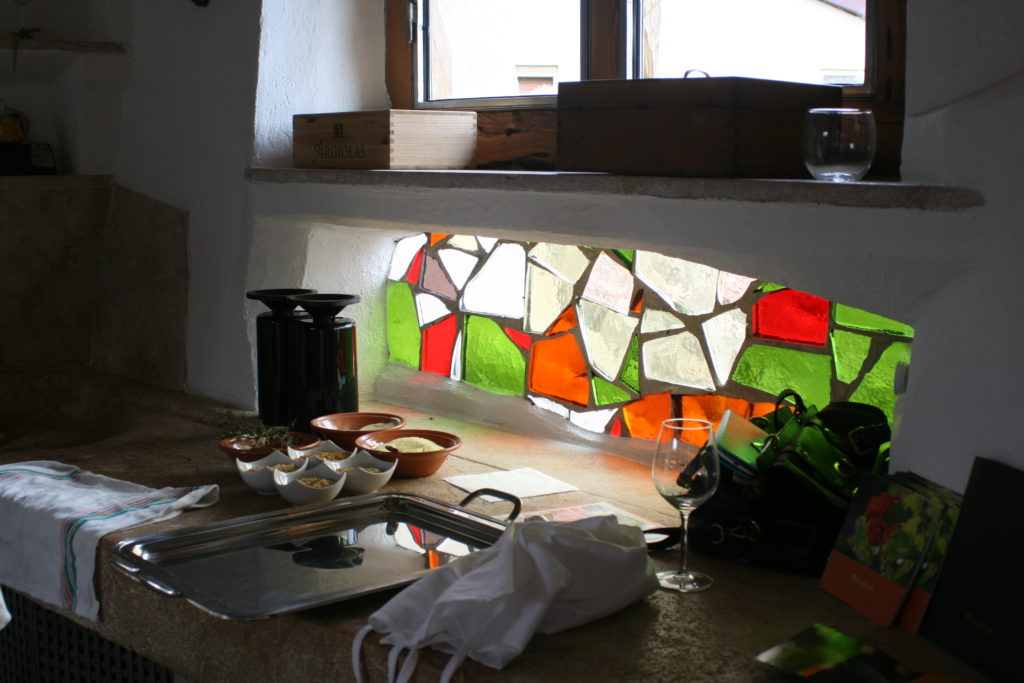

Since Erick and I were the only two signed up for the Sardinia culinary experience that day, we left the menu planning up to the experts at Argiolas. We were completely open to whatever worked for the chefs. Our only request was that it be an authentic cooking experience unique to Sardinia alone. We’ve already made our fair share of handmade pasta, ravioli and gnocchi at home.
Our Menu
Appetizers
After getting seated, we had an opportunity to look over the menu for the day and learned we would be tasting Pistoccu bread (Sardinian cracker-thin flatbread) with tomatoes & bottarga (salted, cured fish roe of the mullet or Bluefin tuna) and making Sardinian fregola-a semolina durum wheat pasta similar to Israeli couscous, but the pearls are a little larger in diameter, toasted and then cooked to have a unique texture and mouth-feel all their own. Being a foodie and half Italian, I was a little embarrassed to admit that I had never even heard of fregola before coming to the class! But nonetheless, I was SUPER excited to learn how to make it from scratch. I wanted to put all of my first-time fregola experiences in my past.

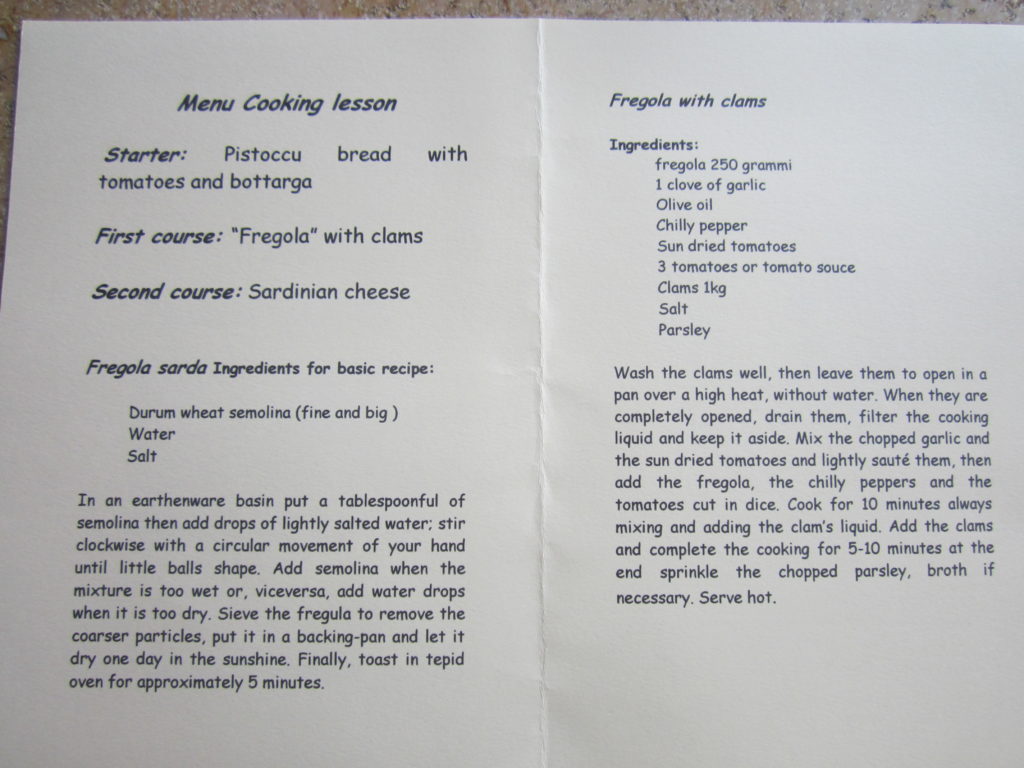
Main Course
After enjoying our appetizer of Tomatoes on Pistoccu bread with Bottarga + wine pairing, we went through the steps in making Sardinian fregola. Matilda and her assistant explained the process of how we would create the fregola, and how it needed to air dry in the sun for a while afterwards. It’s important to let it air dry to create the perfect texture. That way we could enjoy it at the end of our class with our clams and red sauce. By the way, my heart was melting at this point…perfectly sun-dried fregola pasta with clams and locally-sourced tomatoes? (((Swoon)))
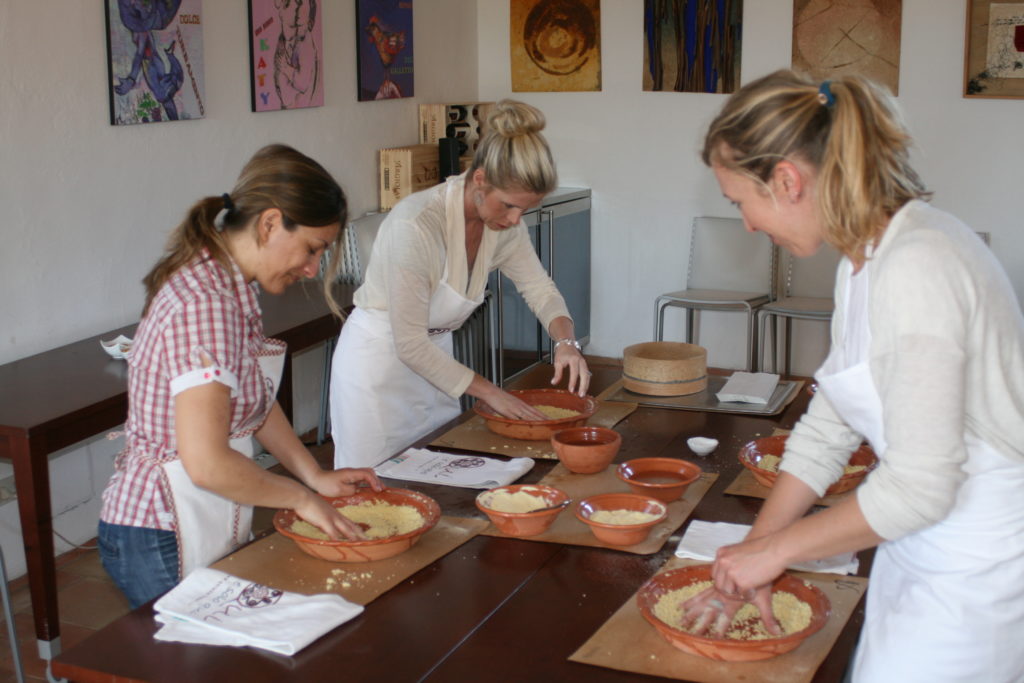
Fregola is made of unbelievably simple ingredients-semolina durum wheat + water. It’s the technique and artistry that goes into homemade fregola that makes it a bit…tricky, at first.
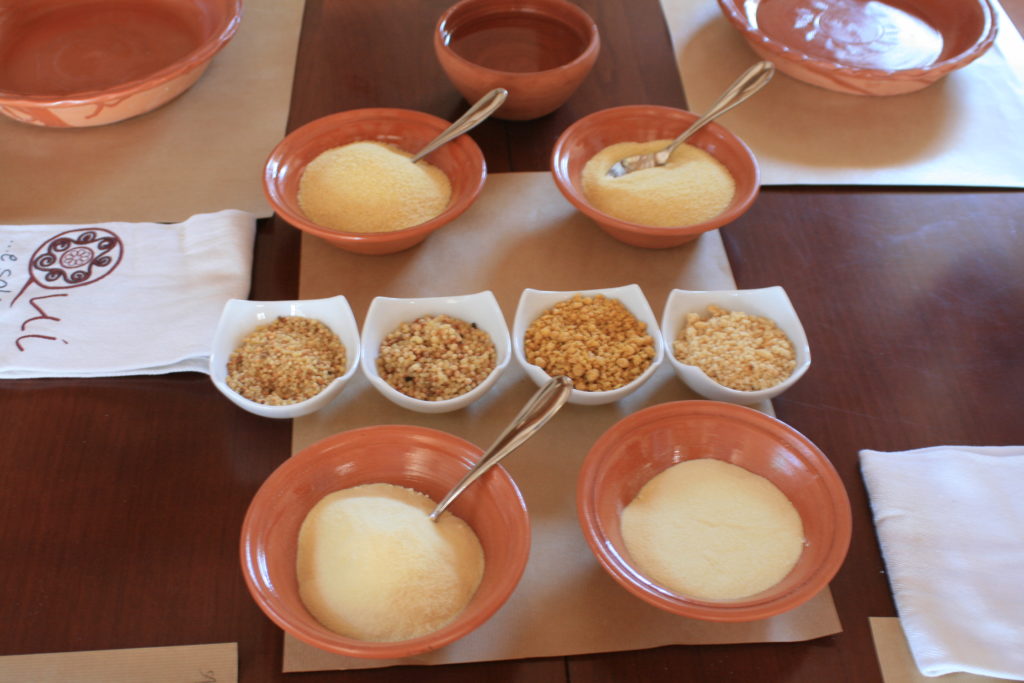
Essentially, one takes a handful of semolina durum wheat (which I’m fairly certain was handpicked by the Jesus himself) and places it in a shallow terracotta bowl. Then with one hand, wets thy fingers with water and starts to swirl in a clockwise motion until ‘pearls’ or very small balls of pasta start to clump up. After your fingers dry a bit, wet your fingers again-but not too much…and just enough-to add more water to the semolina durum wheat. Continue swirling the wheat in that clockwise motion until ‘pearls’ form.
After enough swirling creates large enough ‘pearls’ to be pulled out of the remaining semolina durum wheat, you can then run the mixture through a medium-sized sieve to extract the pearls from the remaining wheat. Continue with this process until you reach the point where you have enough pearls to make the quantity of fregola you’d like to cook, or until your arm falls off from the swirling motion.

At this point, you may take the fregola pearls and place them on a baking sheet to lay out in the Sardinian sun to dry. Alternatively, if you are not in Sardinia, you can just keep them on your counter until they’re dried enough and no longer squishy! This is similar to how homemade pasta dries out before storing or cooking it.
Mid-day Break: Argiolas Winery Tour
While our fregola was drying, we enjoyed a tour of the vineyard & winery facility along with a tasting of several of their most popular wines. The tour was incredible! Their wine making facility is state-of-the-art & their employees were so incredibly kind. Argiolas wines-absolutely exquisite! We’ve visited wineries in Napa, Sonoma, Tuscany…but honestly, there was something different about Argiolas. It was small, but large enough to compete on a global scale. It felt homey without appearing young and inexperienced. In fact, the winery was founded in 1938 by Antonio Argiolas, so their wines and facility have quite a long history.
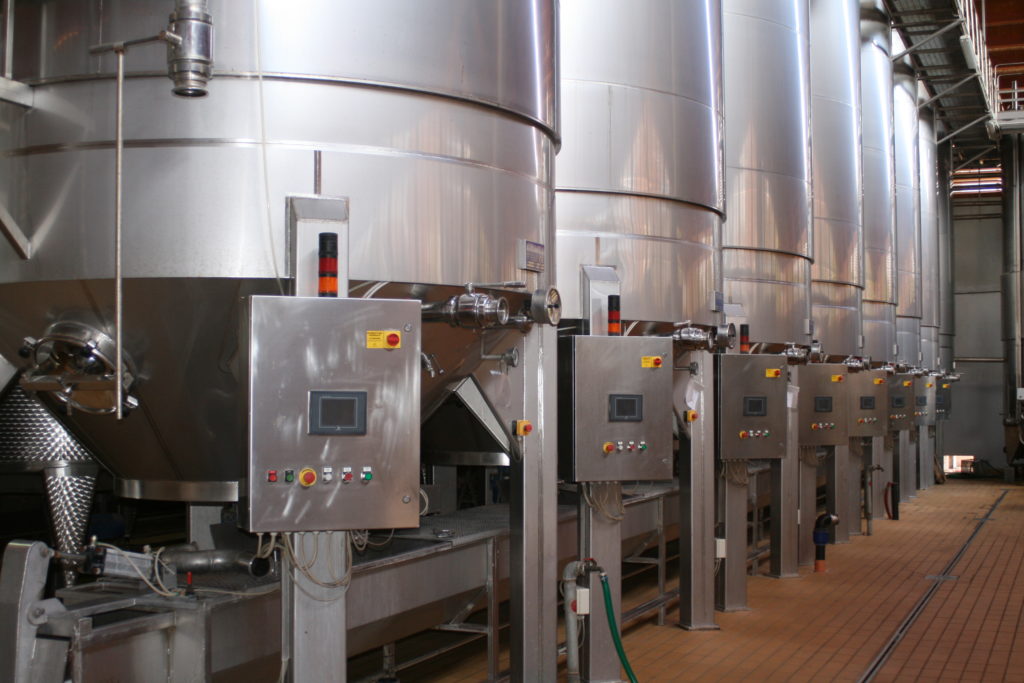
A little side note: 5 years later we still order cases of their Costamolino Vermentino & Cannanou every single year. Argiolas wines have become our go-to red & white table wines to keep on hand. That’s how much we love their wine. Below: picture of the label on their Costamolino Vermentino wine bottles.

Cooking & Eating + Perfect Wine Pairing
After the detailed winery tour, we settled back in to our cooking class kitchen. There, we found Matilda and her assistant working vigilantly to set up the next steps of our fregola cooking process.

The dried pasta was cooked in water until just al dente. Next, we sauteed fresh tomatoes with garlic, olive oil, chili peppers, sun dried tomatoes, clam liquid, salt and a little pasta water to create the most delicious, slightly-spicy red sauce. This sauce accompanied the fregola ever so perfectly.
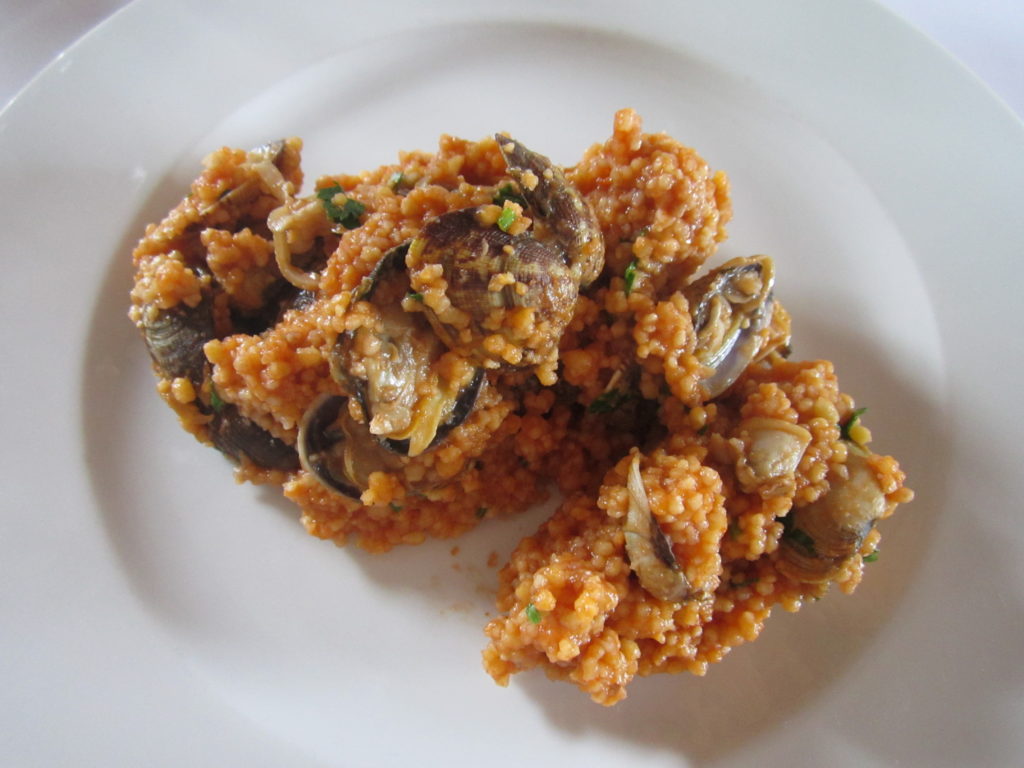
We finished off the meal of our Sardinia culinary experience with a course of local Sardinian cheeses…

And a gorgeous, ruby-red Argiolas apertif…

As with all good things (or perfect things, in our book)…they must eventually come to an end. I’d have to say this Sardinia culinary experience came to an end all too soon. And, even though we spent our entire day learning to create fregola, touring the Argiolas winery and making newfound friendships with the Argiolas staff, we could have stayed forever!
I can’t wait to go back to Sardinia someday & visit Argiolas Winery and their fantastic team of chefs and wine makers. This place was an absolute treasure! And, if you are looking for inspiration for your next culinary holiday, click here to find out more about their culinary options!
Fregola Sarda Recipe
If you aren’t planning to head to Sardinia anytime soon and would like to create a fregola dish (made with store-bought fregola pasta), please check out my recipe for Sardinian fregola pasta with mussels below! This recipe was inspired by our culinary adventure at Argiolas. Fregola can be purchased at any specialty Italian grocer or easily found online.
To learn more about our culinary journeys and the recipes inspired by our travels, check out my post on taking a wood-fired cooking class at the Mugnaini culinary school! Also, never miss a recipe or adventure by subscribing to my newsletter! It is sure to be one fantastic, amazing (sometimes entertaining!) adventure!
Travel Advisor Services
I offer a full service global travel agency in addition to my blog. I would be honored to help you curate the vacation of your dreams – whether it’s Sardinia or anywhere else in the world! For more information, please contact me:
218-259-7090 or tarahallie@hotmail.com
Addio per ora amici! (Goodbye for now, friends!)
Fregola Sarda with Roasted Tomatoes & Mussels
A delicious take on our southern Sardinian culinary journey...enjoy!
Ingredients
- 1 lb. mussels (fresh is best, but frozen is OK)
- 3 T. chopped fresh parsley
- 2-3 pinches red pepper flakes
- 1-1.5 cups dry white wine, such as Argiolas Costamolino Vermentino or pinot grigio you enjoy drinking
- 14 oz. can San Marzano tomatoes (Roma tomatoes can be substituted if San Marzano's not available)
- Fennel bulb fronds (for garnish-optional, but pretty!)
- 1 pint cherry tomatoes
- 2 cloves garlic, minced
- 1/4 cup EVOO (extra virgin olive oil), divided
- 1 cup seafood stock (or vegetable stock if seafood not available)
- Sea Salt & freshly ground black pepper, to taste
- 9 oz. Fregola pasta
Directions
- Step 1 Roast Tomatoes: Heat oven to 425 F degrees. Place 1 pint of cherry tomatoes on a rimmed baking sheet (to collect the juices) lined with parchment paper. Drizzle with 2 T. EVOO and sprinkle with salt and pepper. Toss to coat evenly and place them in the oven and roast, for about 30 minutes. Roast until the tomatoes are slightly blistered and softened and skins can slide off easily.
- Step 2 Remove baking sheet from the oven and allow tomatoes to cool slightly on the pan. Once cool to the touch remove the skins and discard, reserving tomato flesh and juices.
- Step 3 Prepare the mussels: Place the mussels in a shallow sauce pan or brazier with about 3/4 up dry white wine. Heat the burner to medium-high heat and steam, covered, for about 3-4 minutes until valves open.
- Step 4 Remove mussels with a strainer or tongs and place in a bowl with a lid, set aside.
- Step 5 In the pan with the mussel steaming liquid, add the roasted cherry tomatoes and their juices along with the 14 oz. can of San Marzano tomatoes, chopped parsley, seafood (or vegetable) stock and salt and pepper to taste. Using a potato masher, or similar tool, smash the tomatoes until soft and more liquid in consistency.
- Step 6 In a separate pan, about 6 qt. in size, place the remaining 2 T. EVOO, dried fregola pasta and mixed garlic and sauce dried pasta in oil on medium heat until the garlic becomes fragrant, about 2 minutes.
- Step 7 Slowly add 2 ladle-fulls of mussel/tomato liquid and stir a few times. This pasta cooks similar to risotto. You add liquid slowly, but we do not stir as frequently as with risotto.
- Step 8 Let the pasta cook in the liquid and add ladle-fulls as you see the pasta mixture dry out. Be careful not to let it stick/burn to the bottom of the pan.
- Step 9 Fregola is finished when al dente in texture and slightly chewy and liquid has been absorbed, about 15-20 minutes.
- Step 10 A few minutes before the pasta looks done, shell half of the mussels and add those to the pasta mixture. Reserve the other half of the mussels (with shells intact) for garnishing.
- Step 11 Serve in pasta bowls with mussels and fennel bulb fronds on top. Enjoy!


